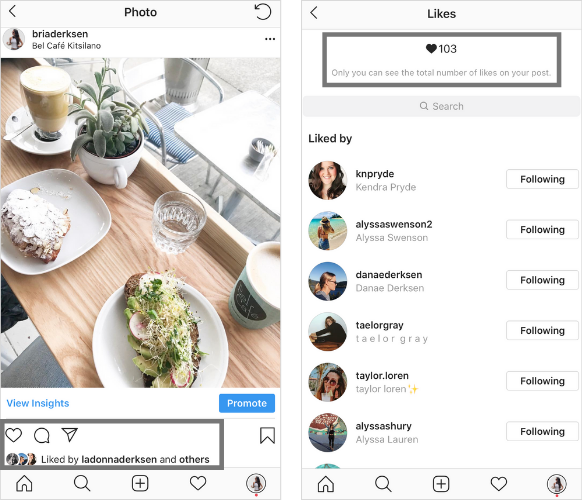When Instagram came out with new tests, it added something to its platform.
The latest test is to remove the amount of likes that users see on an Instagram post.
The test initially started in Canada but will now be rolling out to the following countries: Australia, Brazil, Ireland, Italy, Japan, and New Zealand.
In this article I’m going to discuss where the likes have gone and the impact it will have on marketing and working with influencers.
The new look
If you live in any of the countries where Instagram is currently testing this, your Instagram feed may look something like this:
Before, you saw this:
 In the new update it will only show one username and the tag ‘others,’ whereas in the past it showed a single username and the exact amount of people who liked a post in total.
In the new update it will only show one username and the tag ‘others,’ whereas in the past it showed a single username and the exact amount of people who liked a post in total.
Before: Liked by wwesheamus and 11,571 others
After: Liked by wwesheamus and others
Only the person who made the post can see the total number of likes if they click on ‘others.’ It will show the exact number of likes.

Currently, there is no way to opt in or opt out of this feature. Instagram hasn’t said too much other than it’s currently testing this feature because it wants users to focus less on how many likes a post receives and more on building connections with others.
What will be the impact?
The average social media user places a lot of weight on likes and follower count; the more likes/followers a person receives, the more popular they are online.
When people question who the biggest celebrities in the world are, metrics such as total followers and likes per post are often put into the mix.
Social media is still a new technology given how long we have been on the planet. It can do a lot of good in terms of connecting us with more people, but it can also do harm.
For example, some users are constantly checking to see how many likes their posts receive and even delete a post a few minutes later if they don’t hit a certain number.
Whether social media has an impact on mental health is unknown at this point, but Facebook and Instagram are taking the issue very seriously and hitting it head-on with this test.
The amount of likes a post has is what we call a ‘vanity metric’ (things you can measure that don’t really matter).
I could take a photo of my cat, run a $50 Facebook or Instagram ad using the PPE objective and receive thousands of likes in a short space of time, or I could buy 10,000 likes for about $5.
These thousands of likes don’t turn into revenue and they don’t validate that my cat is cute and will start receiving movie roles.
Taking a real-life example, Instagram influencer Arii had over two million followers and was unable to sell 252 pieces of her new clothing line to her fans.
There are many ways you can look at her story, but the key takeaway is that the amount of followers or likes you receive doesn’t always translate into revenue.
If this feature rolls out globally and becomes the new standard, then influencers may receive fewer inquiries as marketers are now unable to gauge how much engagement the influencer receives per post.
This can be resolved somewhat by having a media kit, but ultimately the influencers who post the best content and build the strongest communities will come out on top – that’s how the game works.
I’m sure that most of us have taken at least two photos of the same thing and used the best shot for a Facebook or Instagram post. You have probably even debated whether it’s post-worthy and not posted in the fear of the image not looking good enough for the Gram.
With the removal of likes, influencers can be more creative and post what they want and not have the backlash or fear that others will see them as less relevant because of likes, which is GREAT for social media.
Like or not to like?
A like on Instagram is a low-intent action that can be manipulated very easily and may cause users anxiety and stress if the number of likes isn’t high enough.
The removal of likes will be a good thing in the long term, not only for influencers but for the everyday user.
Maybe this update will get the lurkers (someone who uses Facebook or Instagram but never posts) out of the shadows and start posting without the fear of worrying over whether people will like their content.
My advice for all Instagram influencers is not to worry about your likes being hidden but to focus on posting quality content because that is what will win in the long term.
